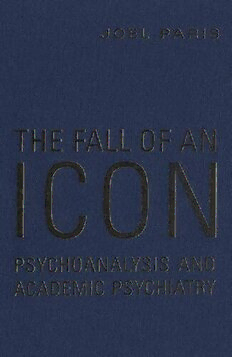
The Fall of An Icon: Psychoanalysis and Academic Psychiatry PDF
Preview The Fall of An Icon: Psychoanalysis and Academic Psychiatry
THE FALL OF AN ICON: PSYCHOANALYSIS AND ACADEMIC PSYCHIATRY Over the last few decades, academic psychiatry has undergone a revolu- tion. After the Second World War, most department chairs were psycho- analysts who belonged to separate institutes, not subject to the checks and balances of academia, and who did not subscribe to the tenets of scientific medicine. The revolution against psychoanalytic dominance began when a group of psychiatrists developed an evidence-based model that brought psychiatry back into the medical mainstream. In The Fall of an Icon, Joel Paris traces the history of this transition, placing it in the context of current trends in science and medicine. He illustrates the story using interviews with prominent academic psychia- trists in Canada and the United States, and describes his own experi- ences as a psychiatrist: how he was caught up in the excitement of the psychoanalytic model, how he became disillusioned with it, and how he came to a new and more scientific view of his discipline. This is an essen- tial work for understanding the recent history of psychiatry. JOEL PARIS is a professor in the Department of Psychiatry at McGill Uni- versity. This page intentionally left blank The Fall of an Icon Psychoanalysis and Academic Psychiatry JOEL PARIS UNIVERSITY OF TORONTO PRESS Toronto Buffalo London www.utppublishing.com University of Toronto Press Incorporated 2005 Toronto Buffalo London Printed in Canada ISBN 0-8020-3933-2 (cloth) ISBN 0-8020-3772-0 (paper) (®) Printed on acid-free paper Library and Archives Canada Cataloguing in Publication Paris, Joel, 1940- Fall of an icon : psychoanalysis and academic psychiatry /Joel Paris. Includes bibliographical references and index. ISBN 0-8020-3933-2 (bound). ISBN 0-8020-3772-0 (pbk.) 1. Psychoanalysis - Canada - History. - 2. Psychoanalysis - United States - History. 3. Psychiatry - Canada - History - 20th century. 4. Psychiatry - United States - History - 20th century. I. Title. RC506.P37 2005 616.89'17'0971 C2004-905762-6 University of Toronto Press acknowledges the financial assistance to its publishing program of the Canada Council for the Arts and the Ontario Arts Council. University of Toronto Press acknowledges the financial support for its publishing activities of the Government of Canada through the Book Publishing Industry Development Program (BPIDP). This book is dedicated to Ned Shorter This page intentionally left blank Contents ACKNOWLEDGMENTS IX Introduction 3 Part One: Hegemony 1 Psychoanalysis and Psychiatry 17 2 Three Famous Universities 38 3 The Inner World of Psychoanalysis 51 Part Two: Challenge 4 Counter-Revolution 73 5 A Shrinking Perimeter 92 6 Transition and Takeover 115 Part Three: Decline 7 The Future of Psychoanalysis 139 8 The State of Contemporary Psychiatry 161 Afterword: Why They Believed 179 NOTES 189 LIST OF INTERVIEWS 219 INDEX 221 This page intentionally left blank Acknowledgments This book is dedicated to Edward Shorter, professor of the history of Medicine at the University of Toronto. I owe Ned a great deal. The author of a standard text, A History of Psychiatry (New York: Wiley, 1998), Ned suggested I should focus this book on academic psychiatry, the set- ting I know best. He read every chapter several times, each time making valuable suggestions for improvement. I also received early encouragement for this project from Allan Young, professor in the Faculty of Medicine at McGill University. Roz Paris read the manuscript carefully and gave me very helpful input. Judy Grossman aided me in finding obscure references. I am grateful to the academic psychiatrists who agreed to be inter- viewed for this book. Each of them donated valuable time, both in talk- ing to me and in reviewing and correcting my notes from the interviews. Their names are listed at the end of this volume. The reader may note that all the psychiatrists I formally interviewed work in the United States. Most of the changes in psychiatry I describe in this book began there, and then spread to Canada. I needed more direct knowledge of how events unfolded south of the border. At the same time, I have related many personal experiences and developments that belong to the history of Canadian psychiatry. I would therefore like to acknowledge my teachers at McGill University, as well as colleagues in Montreal and elsewhere in Canada who have enriched my understand- ing of psychiatry over several decades.
